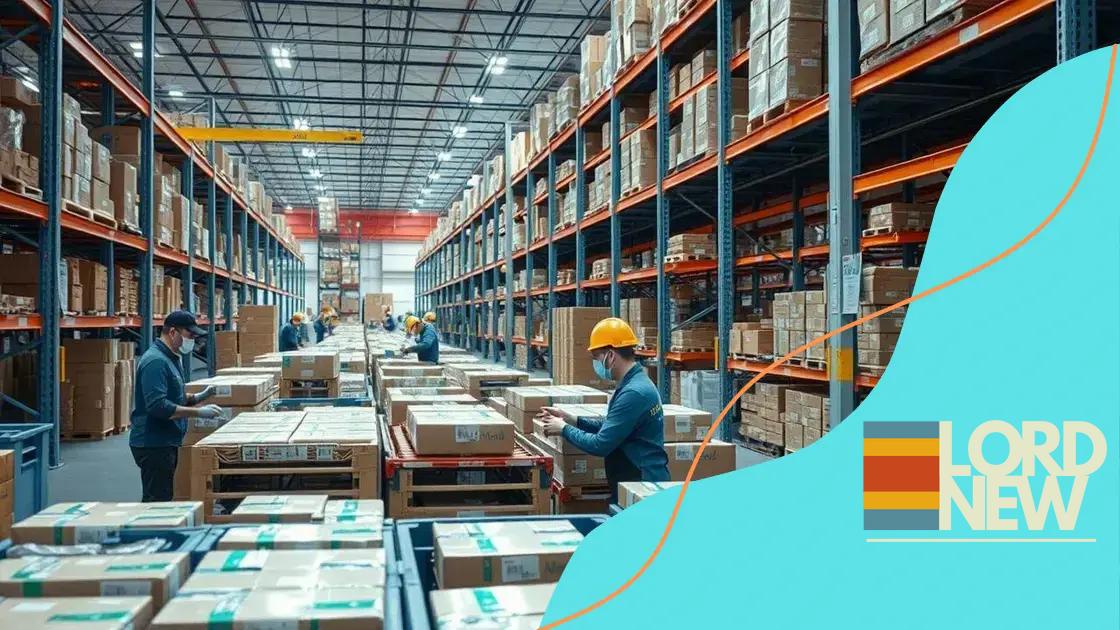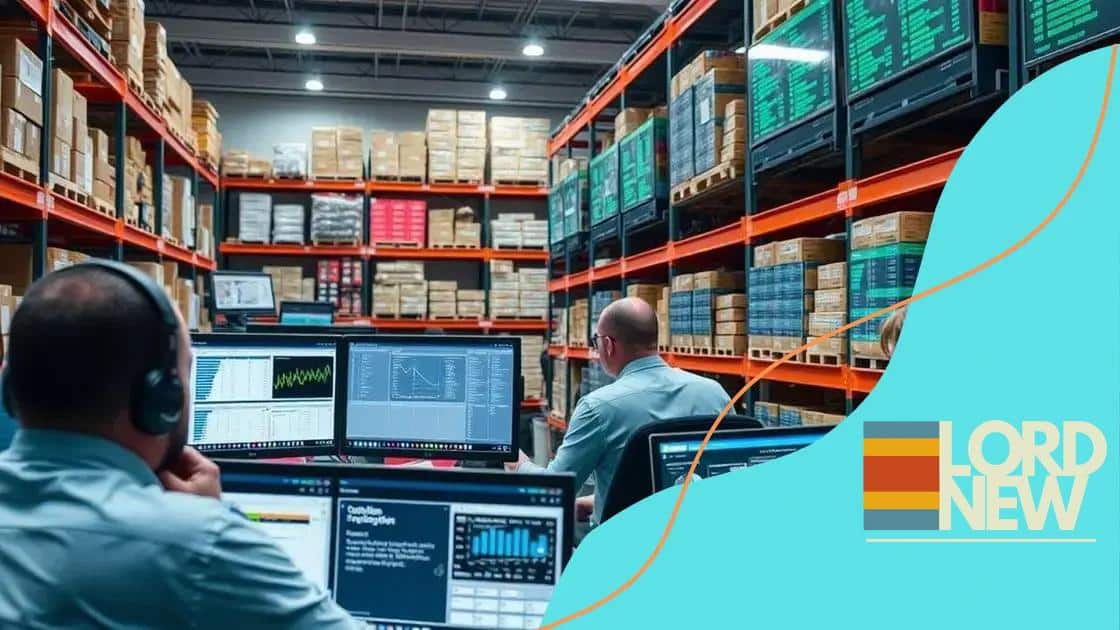How Shein optimizes logistics to reduce costs effectively

How Shein optimizes logistics to reduce costs involves utilizing technology, forming strategic partnerships, and embracing sustainable practices to enhance efficiency and customer satisfaction.
How Shein optimizes logistics to reduce costs is a captivating journey into the world of fashion retail efficiency. Ever wondered how a global brand like Shein stays so competitive? Let’s dive into their logistics gameplan.
An overview of Shein’s logistics strategy
Shein has mastered the art of logistics, ensuring their products reach customers efficiently. Understanding Shein’s logistics strategy is key to comprehending their market success. Their approach begins with optimizing supply chains, allowing them to manage costs effectively while keeping pace with fast fashion trends.
Key Elements of Shein’s Logistics
Firstly, technology plays a vital role in streamlining operations. Shein utilizes advanced software to track inventory and shipments, minimizing delays. This tech-savvy method enables real-time updates, keeping customers informed about their orders.
Inventory Management
Another crucial element is inventory management. Shein’s unique approach helps maintain a balance between supply and demand, preventing excess stock. This is achieved through:
- Data-driven forecasting tools.
- Real-time analysis of consumer trends.
- Efficient use of warehouse space.
By relying on these techniques, Shein avoids markdowns and enhances profitability. Moreover, their partnerships with local manufacturers allow for faster turnaround times, bringing trends to shelves more quickly than competitors.
Each of these strategies is closely linked. For example, utilizing real-time data to adjust production levels can significantly reduce unnecessary costs. As they continue to evolve, incorporating feedback and new technologies, Shein remains at the forefront of the fast fashion logistics scene.
The Role of Partnerships
Collaboration is a vital aspect of Shein’s logistics strategy. By forging strong ties with suppliers and logistics partners, they ensure a seamless flow of goods. This collaborative effort not only optimizes supply chains but also enhances the quality of service offered to customers.
Key technology used in Shein’s supply chain
Technology is at the heart of Shein’s supply chain, enabling the brand to stay competitive in a fast-paced market. Understanding the key technologies Shein employs reveals how they streamline their logistics and enhance customer satisfaction.
Data Analytics
One crucial aspect is data analytics. Shein utilizes advanced systems to gather insights on customer preferences and buying patterns. By analyzing this data, they can predict trends and adjust production accordingly.
- Real-time tracking of sales data.
- Identification of emerging fashion trends.
- Optimization of inventory levels.
This continuous flow of information allows Shein to respond rapidly to market changes and maintain a lean inventory.
Automated Warehousing
Another important technology is the use of automated warehousing. Shein’s warehouses are equipped with sophisticated robotics that manage the sorting and packing of items. This technology increases efficiency, reduces errors, and speeds up the fulfillment process.
Additionally, automation helps in minimizing labor costs and maximizing space utilization within warehouses, which is essential for large-scale operations.
Collaboration with third-party logistics providers also enhances the effectiveness of their supply chain. By integrating cloud-based platforms, Shein can ensure seamless communication and coordination with partners. This capacity for real-time collaboration means that deliveries can be executed more smoothly, benefiting customers with faster shipping times.
Blockchain Technology
Another emerging technology in Shein’s supply chain is blockchain technology. This innovative approach enhances transparency and traceability of products. Implementing blockchain allows Shein to track the origin of materials used in their clothing, ensuring ethical sourcing and boosting consumer trust.
On the whole, utilizing these advanced technologies places Shein ahead of the curve in the competitive world of fast fashion. With constant adaptation and innovation, the brand can meet the ever-changing demands of its diverse customer base.
How Shein manages inventory efficiently

Effective inventory management is crucial for Shein’s success in the fast fashion market. By focusing on efficient inventory strategies, Shein can respond quickly to changing trends and customer demands. This approach not only minimizes overstock but also ensures popular items are always available.
Just-In-Time Inventory
One of the key techniques employed by Shein is the just-in-time (JIT) inventory system. This means that they produce goods based on actual demand rather than forecasts. By closely monitoring sales data, Shein can adjust production levels accordingly. This method reduces storage costs and minimizes waste from unsold items.
- Real-time sales tracking for better decision-making.
- Timely production schedules eliminate excess inventory.
- Improved cash flow management by reducing holding costs.
This strategy allows Shein to remain agile and adapt quickly to fashion trends.
Data-Driven Decision Making
Using data analytics plays a fundamental role in managing inventory efficiently. Shein analyzes customer purchasing patterns to make informed decisions about which products to restock. This insight helps them to identify which items are most popular and need additional inventory.
Through predictive analytics, Shein anticipates future demands, making it easier to maintain the right stock levels. This approach reduces the risk of stockouts and keeps customers satisfied with timely deliveries.
Another vital aspect is the use of technology to track inventory in real-time. This technology allows Shein to monitor stock levels at various locations and serves as an early warning system for items that may need replenishment. By utilizing cloud-based software, all team members can access the same data, keeping everyone in sync across the organization.
Partnerships with Suppliers
Shein’s success also stems from strong relationships with suppliers who are integral to their inventory management. By collaborating closely, they can align production schedules with demand, leading to faster turnaround times. These partnerships contribute to reducing lead times, which is essential in the fast fashion industry.
The role of partnerships in logistics optimization
Partnerships play a vital role in the logistics optimization of Shein. Establishing strong connections with suppliers, manufacturers, and logistics providers is essential for maintaining efficiency. These partnerships help Shein enhance its supply chain and respond quickly to the demands of the fast fashion market.
Collaboration with Suppliers
One important aspect is collaboration with suppliers. By building close relationships, Shein can align production timelines with demand. This cooperation ensures that materials arrive on time, reducing delays in manufacturing.
- Frequent communication to adjust order quantities.
- Shared technology platforms for better visibility.
- Joint planning to meet seasonal demands.
These collaborative efforts allow Shein to fulfill orders more efficiently, ultimately benefiting customers with faster delivery times.
Third-Party Logistics Providers
Collaborating with third-party logistics (3PL) providers also significantly enhances Shein’s logistics strategy. 3PLs offer specialized services that can streamline distribution processes. Working with these partners, Shein gains access to:
- Advanced warehousing solutions that optimize storage.
- Efficient shipping routes to reduce delivery times.
- Scalable logistics to manage peak seasons effectively.
This flexibility is crucial for meeting customer expectations in the competitive fast fashion industry.
The role of technology cannot be overlooked in these partnerships. Implementing shared software solutions allows all parties to track inventory and shipments in real time. This transparency helps mitigate issues that may arise during the supply chain process.
Building Long-Term Relationships
Ultimately, successful logistics optimization requires building long-term relationships. By fostering trust and collaboration, Shein can innovate and adapt to market changes swiftly. These partnerships offer a competitive advantage, ensuring Shein remains responsive to consumer needs.
Future trends in Shein’s logistics approach
The future of Shein’s logistics approach holds exciting possibilities as the company continues to adapt to the fast fashion industry. Innovations in technology and changing consumer preferences are shaping logistics trends that enhance efficiency and customer satisfaction.
Sustainability Initiatives
One significant trend is the commitment to sustainability. As consumers become more eco-conscious, Shein is exploring ways to lessen its environmental impact. By implementing sustainable practices in logistics, Shein can:
- Reduce waste through optimized shipping routes.
- Utilize eco-friendly packaging materials.
- Enhance energy efficiency within their supply chain.
This focus on sustainability not only appeals to customers but also aligns with global efforts for healthier planet practices.
Advanced Data Analytics
Another future trend involves the deeper integration of data analytics. Shein plans to enhance its use of predictive analytics to better anticipate customer needs. By leveraging advanced algorithms, they can:
- Improve inventory turnover rates.
- Reduce lead times by aligning production with real-time demand.
- Provide personalized shopping experiences for customers.
This proactive approach fosters a more responsive supply chain, allowing Shein to stay ahead in the competitive market.
Automation and Robotics
As technology evolves, automation and robotics will play an even larger role in Shein’s logistics operations. Automated systems in warehouses can:
- Streamline sorting and packing processes.
- Minimize errors in order fulfillment.
- Significantly reduce labor costs during peak times.
By incorporating cutting-edge technology, Shein can achieve higher levels of efficiency and accuracy.
Enhanced Customer Engagement
Future trends also suggest a greater focus on customer engagement through logistics. Shein is planning to improve communication with customers regarding order tracking. Implementing more interactive tracking features will:
- Allow customers to view real-time updates of their shipments.
- Provide estimates for delivery times more accurately.
- Enhance overall shopping experiences by keeping customers informed.
By focusing on these future logistics trends, Shein aims to reinforce its position as a leader in the fast fashion industry while prioritizing customer satisfaction and environmental accountability.
FAQ – Frequently Asked Questions about Shein’s Logistics
How does Shein utilize technology in its logistics strategy?
Shein uses advanced technology like data analytics and automation to streamline operations and meet customer demands efficiently.
What role do partnerships play in Shein’s logistics optimization?
Partnerships with suppliers and third-party logistics providers enhance efficiency by ensuring timely deliveries and aligning production with demand.
How is Shein addressing sustainability in its logistics?
Shein is implementing eco-friendly practices such as reducing waste, using sustainable packaging, and optimizing shipping routes for a lower carbon footprint.
What are future trends in Shein’s logistics approach?
Future trends include greater data analytics integration, expanded automation, and enhanced customer engagement through real-time order tracking.





